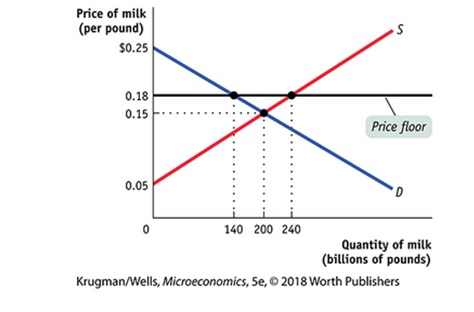
In 2014, U.S House of Representatives approved a farm bill establishing the margin protection program (MPP) for dairy produces. The MPP supports dairy farmers when the margin between feed cost and milk prices falls below $0.08 per pound. Current feed cost is $0.10 per pound, which means the program creates a prices floor for milk at $0.18 per pound. At the price, in 2015 the quantity of milk supplied is 240 billion pounds, and the quantity demanded is 140 billion pounds. To support the price of milk at the

- The
consumer surplus andproducer surplus created in the absence of floor price and also calculate the total surplus. - When the floor price is $0.18, and the consumers buy 140 billion pounds of milk, calculate the amount of consumer surplus
- When the floor price is $0.18, and the producers sell 240 billion pounds of milk, calculate the producer surplus
- The money spent by the USDA to buy surplus milk
- The total surplus when there is a floor price and how does the total surplus compare to the total surplus without a floor price
Concept Introduction:
Consumer Surplus:
Consumer surplus is the difference between the maximum amount the consumer is willing to pay for a good and the amount the consumer actually pays.
Producer Surplus:
The producer surplus is the difference between the amount that a producer receives and the minimum amount the producer is willing to accept to part with the good. In other words, the producer surplus of a firm is the sum over all units produced of a difference between the market price and the marginal cost of production.
Total Surplus:
Total surplus is the sum of consumer surplus and producer surplus.
Floor Price:
It is a government-imposed price control or limits on the minimum price that can be charged for a product. A floor price must be higher than the market price to be effective.
Want to see the full answer?
Check out a sample textbook solution
Chapter 5 Solutions
Microeconomics (Instructor's)

 Principles of Economics (12th Edition)EconomicsISBN:9780134078779Author:Karl E. Case, Ray C. Fair, Sharon E. OsterPublisher:PEARSON
Principles of Economics (12th Edition)EconomicsISBN:9780134078779Author:Karl E. Case, Ray C. Fair, Sharon E. OsterPublisher:PEARSON Engineering Economy (17th Edition)EconomicsISBN:9780134870069Author:William G. Sullivan, Elin M. Wicks, C. Patrick KoellingPublisher:PEARSON
Engineering Economy (17th Edition)EconomicsISBN:9780134870069Author:William G. Sullivan, Elin M. Wicks, C. Patrick KoellingPublisher:PEARSON Principles of Economics (MindTap Course List)EconomicsISBN:9781305585126Author:N. Gregory MankiwPublisher:Cengage Learning
Principles of Economics (MindTap Course List)EconomicsISBN:9781305585126Author:N. Gregory MankiwPublisher:Cengage Learning Managerial Economics: A Problem Solving ApproachEconomicsISBN:9781337106665Author:Luke M. Froeb, Brian T. McCann, Michael R. Ward, Mike ShorPublisher:Cengage Learning
Managerial Economics: A Problem Solving ApproachEconomicsISBN:9781337106665Author:Luke M. Froeb, Brian T. McCann, Michael R. Ward, Mike ShorPublisher:Cengage Learning Managerial Economics & Business Strategy (Mcgraw-...EconomicsISBN:9781259290619Author:Michael Baye, Jeff PrincePublisher:McGraw-Hill Education
Managerial Economics & Business Strategy (Mcgraw-...EconomicsISBN:9781259290619Author:Michael Baye, Jeff PrincePublisher:McGraw-Hill Education





